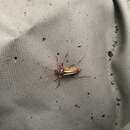Conservation Status
provided by University of Alberta Museums
Not of concern.
- license
- cc-by-nc
- copyright
- University of Alberta Museums
Cyclicity
provided by University of Alberta Museums
Adults fly in June and July (Linsley and Chemsak 1972).
- license
- cc-by-nc
- copyright
- University of Alberta Museums
Distribution
provided by University of Alberta Museums
The type locality is the Mississippi valley (Hopping 1937). Specimens have also been recorded from Alberta, Manitoba, Missouri, Wyoming, New York, Pennsylvania, Maine and Illinois (Aurivillius 1912; Hopping 1937; Leng 1890; Linsley and Chemsak 1972).
- license
- cc-by-nc
- copyright
- University of Alberta Museums
General Description
provided by University of Alberta Museums
Length 12-16 mm (Linsley and Chemsak 1972). The head is black (Say 1859) and small, gradually converged behind eyes (Linsley and Chemsak 1972). The eyes are faceted or with a smooth polish and emarginate or notched (Linsley and Chemsak 1972). The antennae are rufous in color with prominent tubercles (Linsley and Chemsak 1972) and are shorter than the elytra. The third antennal segment is shorter than the fourth. The fifth antennal segment is equal in length to the third (Linsley and Chemsak 1972). The thorax has uneven anterior and posterior impressed bands and a dorsal impressed line (Say 1859). The elytra are black with parallel broad lateral yellow vittae or stripes that do not reach the tip (Linsley and Chemsak 1972). The margins of the elytra are rufous in color and separated from the vitta by a black line near the base and the humerus is prominent (LeConte 1859). The body is black ventrally with golden pubescence (Say 1859). The legs are rufous or yellow in color (Hopping 1937).
- license
- cc-by-nc
- copyright
- University of Alberta Museums
Habitat
provided by University of Alberta Museums
As members of the sub-family Lepturinae they are most likely found on flowers.
- license
- cc-by-nc
- copyright
- University of Alberta Museums
Life Cycle
provided by University of Alberta Museums
Most cerambycid larvae are wood boring and may be very destructive to trees impacting forestry and agriculture (Triplehorn and Johnson 2005).
- license
- cc-by-nc
- copyright
- University of Alberta Museums
Trophic Strategy
provided by University of Alberta Museums
All cerambycids are phytophagous and most Lepturinae larvae are wood borers (Triplehorn and Johnson 2005). There is no literature that directly indicates that S. trivittatus is a flower dwelling species. However if S. vittiger is accepted as a synonym of S. trivittatus then host flowers include Vibernum, Hydrangea, Spiraea, Crataegus, Cornus, and Nyssa (Linsley and Chemsak 1972).
- license
- cc-by-nc
- copyright
- University of Alberta Museums
Stenocorus trivittatus
provided by wikipedia EN
Stenocorus trivittatus is a species of beetle in the family Cerambycidae. It was described by Say in 1824.[1]
References

- license
- cc-by-sa-3.0
- copyright
- Wikipedia authors and editors
Stenocorus trivittatus: Brief Summary
provided by wikipedia EN
Stenocorus trivittatus is a species of beetle in the family Cerambycidae. It was described by Say in 1824.
- license
- cc-by-sa-3.0
- copyright
- Wikipedia authors and editors

